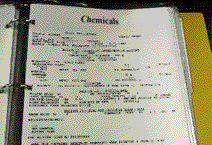| . | CHEMICAL HAZARD COMMUNICATION COMPLIANCE |
. | |
Identifying Workplace Hazardous Chemicals |
|||
|
Look around. Identify chemicals in containers, including pipes, but also
think about chemicals generated in the work operations. For example, welding fumes, dusts, and
exhaust fumes are all sources of chemical exposures.
Read labels provided by the suppliers for hazard information. Make a list of all chemicals
in the workplace that are potentially hazardous. For your own information and planning,
you may also want to note on the list the location(s) of the products within the
workplace, and an indication of the hazards as found on the label. This will help you as
you prepare the rest of your program. Paragraph (b) of the HCS, scope and application, includes exemptions for various chemicals or workplace situations. After compiling the complete list of chemicals, you should review paragraph (b) to determine if any of the items can be eliminated from the list because they are exempted materials. For example, food, drugs and cosmetics brought into the workplace for employee consumption are exempt; as well as rubbing alcohol in the first aid kit. |
||
| . |


